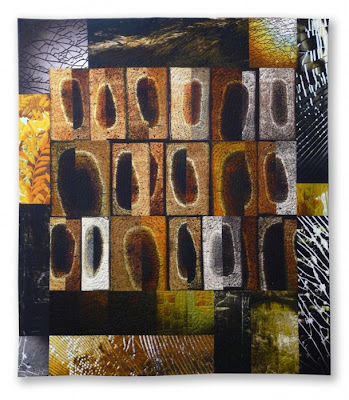Saturday, May 4, 2013
Art readers' digest
Since I never had the opportunity to attend art school, I have had to resort to my own reading and study to learn about art history and theory. But thanks to taking a formal art history course this spring, I've been reading even more about art than I normally do.
Sometimes a bit of reading will spark a lot of thought on my part, which I will post about. And then I keep running into provocative little remarks and paragraphs that aren't enough to spark a full essay, but are too interesting to pass by unremarked. I thought maybe you would be interested in reading them too, so I'm going to start posting them.
Although I won't spend a lot of time reflecting on these readings or telling you what I think, I'd be really interested in what you think about them. Please share your ideas and responses!
Here's the first, from a 1998 book, "Michael James: Art & Inspirations." This was one of a great series done by C&T Publishing, which I think is no longer being done. These books had the virtue of focusing on artists and their work without dumbing it down with project instructions, and did the artists the courtesy of treating their ideas with equal respect as their quilts.
Michael James, Rhythm/Color: Morris Men, 1986
In this book, Patricia Malarcher, the longtime editor of SDA Journal, interviewed James.
Malarcher: Could you define the difference between art, craft, and design?
James: Art is a state, a situation that a work enters when its expressive, symbolic, metaphorical and.or decorative value assumes a communicative power that transcends its materiality. To me, craft is the process, the construction, the technical aspect of producing some object. To a degree, design is technical also, but whereas craft is focused on the construction end of the object, design is focused on the composition -- essentially, on the interweaving of the surface elements -- line, color, form, shape, etc.
Malarcher: But what is it that pushed good design and good craft into art?
James: All I can say is that there's something intangible embodied in a work of art that has the capacity to draw emotional and psychological responses from someone who encounters it. Most objects that are purely functional don't have that intangible quality.
Malarcher: Beyond craftsmanship and design, art today is regarded as something that holds a mirror up to a particular culture and talks back to it in ways that are often confrontationa. Where do you see you work in such a milieu?
James: I don't see that my work really fits in with what's going on in the art world today. It seems to fit in with what is going on in the studio craft movement. What I've said regarding quilts could be said about any studio craft medium like glass, furniture, ceramics, or other textiles. None of those really fit in with the currents of avant-garde art.
Michael James, A System of Classification, 2009
Subscribe to:
Post Comments (Atom)








Thanks, Kathy, for sharing these comments. As someone who did go to art school, I have to agree with Michael James's definitions of art, craft, and design. I do find that beautifully crafted studio craft objects, whatever their mediums, can be very moving and "rise" to the level of art. I also think James's assessment of how textile art today fits (or doesn't fit) into the contemporary art world is spot on. There is not one Art World, but many, and part of our job as artists is to choose which sandbox we want to play in.
ReplyDeleteGood studio craft is a bridge between the culturally isolated segments of society, such as white-bread America, and the art world. The functionality of these pieces appeals to some of middle America, and they take a longer and closer look, which is the first step in appreciating art. Your post today reminded me of your April post about cultural identity and the disdain that some people have for art. I believe that the work of good studio craftsmen can engage and perhaps educate a larger audience about art.
ReplyDelete"None of those really fit in with the currents of avant-garde art." This is an interesting comment as it points to the frustration that the juror at the Art Quilt Elements had in 2012. He was most upset there wasn't more technology in the quilts - he wanted avant-garde and he said the art quilt community failed to measure up.
ReplyDeleteI wrote about this topic (kinda) a while back and it was the topic of my artist talk at my my solo show last fall - a summary is here: http://blog.lisacall.com/2012/10/beautiful-by-design/
A link to further remarks by David Revere McFadden comments about Art Quilt Elements is also referenced.
I do remember that hoohah. If I wanted to list the elements of avant-garde I'm not sure technology would be on top of the list, and it certainly wouldn't be the only element.
DeleteHis quilts don't fit into avant-garde art - but do quilts need to be avant-garde art? Certainly his work is avant-garde quilts, finely crafted ... but as mentioned there are many worlds of art. In some of them, art needn't give pleasure, just be seen to be "art".
ReplyDeleteI'm wondering if quilts can ever be avant-garde art, or if their medium ties them down to another category.
Tracey Emin is avant-garde and she occasionally works in the quilt format, but her treatment of the medium seems totally ironic rather than taking any part of the tradition seriously. Among artists who use quilts non-ironically, you're probably right -- impossible to be avant-garde.
DeleteAnd that raises the other question -- do we even want to be avant-garde????